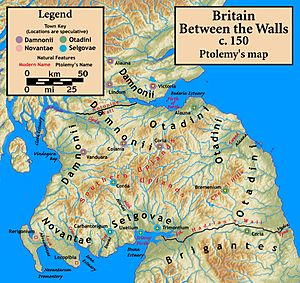Votadini facts for kids
The Votadini were an ancient group of people who lived in what is now Scotland and northern England. They were part of the Brittonic people, who lived in Britain during the Iron Age. Their land stretched from the Firth of Forth in Scotland down to the River Tyne in England. This area included places like Falkirk, Lothian, the Borders, and Northumberland.
For a short time, their land was part of the Roman province of Britannia. The first main town of the Votadini was likely a hill fort called Traprain Law in East Lothian. They moved from there in the early 400s AD. After that, their main center became Din Eidyn, which is now known as Edinburgh.
The name "Votadini" comes from old Roman writings. On ancient maps of Roman Britain, they were sometimes called "Otodini." Later, their descendants formed a kingdom known as Guotodin in Old Welsh, and later as Gododdin.
One of the oldest poems from Britain is called Y Gododdin. It was first told as stories and songs before being written down in Old Welsh. This poem tells about the brave soldiers from a place the Britons called Yr Hen Ogledd – which means "The Old North." It talks about how this land was lost in a big battle at Catraeth, which is now Catterick.
Contents
Early History of the Votadini Land
People lived in the Votadini area a very long time ago, starting around 3000 BC. Special items found at a sacred hilltop called Cairnpapple Hill in West Lothian show that people traded with areas like Cumbria and Wales even back then.
By about 1500 BC, Traprain Law in East Lothian was used as a burial site. Later, around 1000 BC, people lived there and built walls to protect themselves. Digs at Edinburgh Castle have also found old materials from about 850 BC.
Around 800 BC, the Brythonic Celtic culture and language began to spread into this area. This likely happened through people sharing ideas, not just by large groups invading. Over time, different kingdoms started to form. Many hillforts and settlements found today suggest that these tribes sometimes fought with each other, just as the Romans later described.
The Roman Period and the Votadini
In the 1st century AD, the Romans wrote about the Votadini as a British tribe. From 138 to 162 AD, the Votadini's land was directly controlled by the Roman army. This area was between two large Roman walls: Hadrian's Wall and the Antonine Wall.
When the Romans decided to move back to Hadrian's Wall, the Votadini became a friendly "buffer state." This meant they were a friendly area between the Romans and other tribes further north. They got benefits from being friends with Rome without being fully under Roman rule. This lasted until about 400 AD, when the Romans left southern Great Britain. Many Roman goods found at Traprain Law suggest this friendship was helpful for the Votadini.
Later, the Roman province of Britannia was divided into four parts. A new part called Valentia was created. This new area might have included the Votadini's land.
Digs in the Votadini area, especially around Traprain Law, have found Roman silver items and coins from Gaul (modern France). This shows that the Votadini traded with people from the Roman Empire. We don't know if they traded for these items or if the Romans gave them as gifts to keep the peace.
After the Romans Left
After the Romans left Britain in the early 400s AD, the Votadini's land became part of an area known as the Hen Ogledd, or "Old North."
Around 470 AD, a new kingdom called Gododdin formed. It covered most of the land where the Votadini used to live. The southern part of their land, between the River Tweed and the River Tyne, became a separate kingdom called Brynaich.
A famous leader named Cunedda, who started the Kingdom of Gwynedd in north Wales, is believed to have been a Votadini chief. He moved southwest around this time. Both the Gododdin and Brynaich kingdoms fought against the Angles from Bernicia. The poem Y Gododdin by Aneirin tells the story of these battles. The kingdom of Gwynedd, started by Cunedda, remained strong and undefeated until the 1200s.
See also
- Dere Street
- History of North-Humberland
- History of Scotland
- Yeavering Bell


